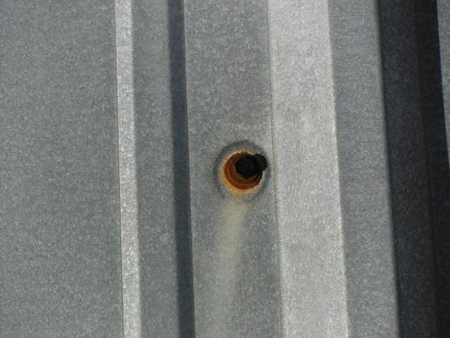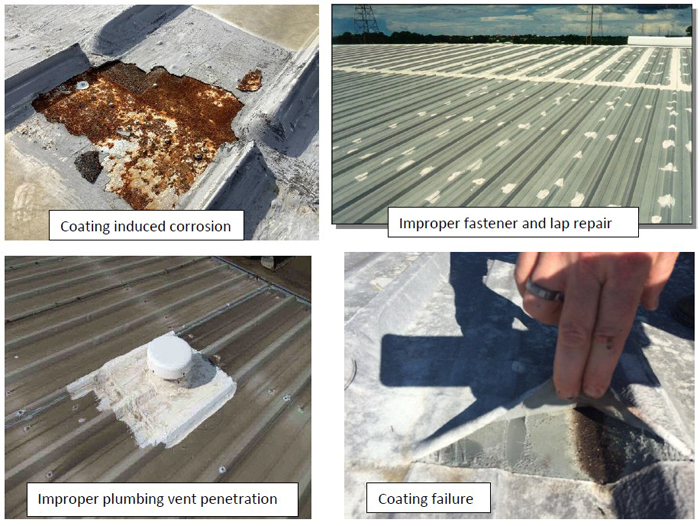 By Dale Nelson, Roof Hugger LLC
By Dale Nelson, Roof Hugger LLC
Every year we provide framing systems that allow a new metal roof to be installed over an existing metal roof. Sadly, in many cases the roof is being replaced not because it had reached the end of its useful life but rather because it had been improperly
repaired. These repairs take many forms but most are along the order of tar, caulk, or other exotic conventional roof coating material that is rolled, sprayed or smeared on the metal panels with the promise of a long term “fix” to the
leak problem.
Metal roofs are the longest life, most maintenance free roofs on the market, but any roof can and will eventually develop a leak. Metal roofs however are a specialty in and of themselves and contractors that do not specialize in metal roofing will frequently
make incorrect and/or seriously damaging repairs. Another important aspect is that most newer metal roofs have 20- to 40-year finish warranties. Improper repairs can easily void these warranties!
Assuming your metal roof has a leak where do you start?
1. Where is the roof leaking? What unit or point in the building has the leak appeared? Approximately how far from the eave going toward the ridge and from one building end along the eave is the drip showing up? Remember metal roofs always have a pitch
and water always runs downhill, so the leak is typically at that point or upslope from that point.
 2. What kind of roof do you have? There are 2 basic types of metal roofs. Screw down (through fastened) and standing seam.
The most common roofs are screw down and they will have from 0.8 - 1.1 fasteners per square foot of roof area. This means if you have a 10,000 sq. ft. roof there could be as many as 11,000 fastener penetrations through the roof. Older fasteners were
often cadmium plated and notorious for breaking down over time and creating a leak. Newer stainless steel and zinc cap fasteners have a significantly longer life span and should always be used. Standing seam roofs typically have very few exposed fasteners
and those would typically be used at the eave or ridge of the roof. These roofs are very reliable and much less prone to leaking but on occasion, even they can have a leak, panel end laps being the most common problem.
2. What kind of roof do you have? There are 2 basic types of metal roofs. Screw down (through fastened) and standing seam.
The most common roofs are screw down and they will have from 0.8 - 1.1 fasteners per square foot of roof area. This means if you have a 10,000 sq. ft. roof there could be as many as 11,000 fastener penetrations through the roof. Older fasteners were
often cadmium plated and notorious for breaking down over time and creating a leak. Newer stainless steel and zinc cap fasteners have a significantly longer life span and should always be used. Standing seam roofs typically have very few exposed fasteners
and those would typically be used at the eave or ridge of the roof. These roofs are very reliable and much less prone to leaking but on occasion, even they can have a leak, panel end laps being the most common problem.
Ok, I have the information I need, now who should I call?
1. First and foremost, call someone who specializes in metal roofing. The typical “roofing contractor” may be highly skilled with shingles, built-up or single-ply systems but metal roofs are totally different. Metal buildings commonly have
the manufacturer's logo and name on the peak or somewhere on the building. Call them for a recommendation; they will have a network of builders and installers they work with. This will also protect any remaining warranty you may have. Don’t
inadvertently void your warranty.
2. If the building is too old or there are no markings remaining, I would suggest any local metal building contractor or metal building erector. Another great resource is the Metal Building Contractors and Erectors Association (MBCEA). This is a group
of qualified metal building specialists that work continuously to maintain the highest quality of workmanship.
But my roofer friend says he can handle the job. No problem, right?
1. Ok, maybe, but ask a lot of questions first. A roof repair does not mean you put caulk, silicone, tar or other foreign material on the metal panels! If a fastener has failed, it should be replaced with a new over-sized long-life fastener not covered
with goop! Caulking or coating fasteners, panel side-laps or panel end-laps is not a fix - it is how you significantly shorten the remaining life of your roof!
 |
2. Remember, metal roofs move constantly. It doesn’t matter if they are screw-down or standing-seam, they move. Because of that, metal roofs also have their own specialized group of accessories for pipe penetrations, roof openings, snow retention
and other roof-mounted equipment. Never allow another contractor - i.e.: plumbing, electrical, mechanical or other profession - to penetrate your metal roof. They don’t understand them and they will not do it correctly. They also not properly
trained on how to walk on a metal roof. Uncontrolled foot traffic can do serious damage to your roof.
Conclusion
1. Understand that if you have a metal roof, then you have a top-of-the-line roof system. It requires a company that specializes in metal roofs to repair it if you have a problem. Get the right guys to guide you on repairs. Ask questions as to how they
intend to make the repair; have them provide pictures.
2. Caulking or coating over problems on a metal roof will quickly cause a myriad of other problems: some voiding your warranty, others creating life-shortening and double expense problems for your roof.
3. If you need to modify the roof, add openings, equipment, etc., get a specialist; shortcuts here are not good. Metal roofs have specially designed accessories that allow for movement and proper sealing. Conventional roofing products are not designed
for use on metal roofs.
4. If the roof truly has reached the end of its life, replace it with another metal roof. That’s what the building was designed for. Use a retrofit system that is fully engineered and can document that it will comply with the latest building codes
for wind and snow loads. This will enhance your insurability and resale. It will also give you the lowest, long-term cost for your investment.
5. Check out those tax credits, section 179 of the tax code may allow writing off up to $1 million. This will make the whole retrofit process much easier.